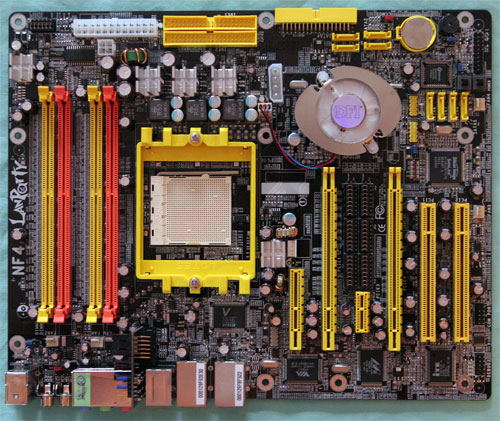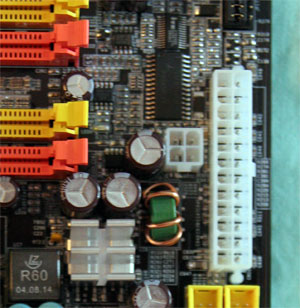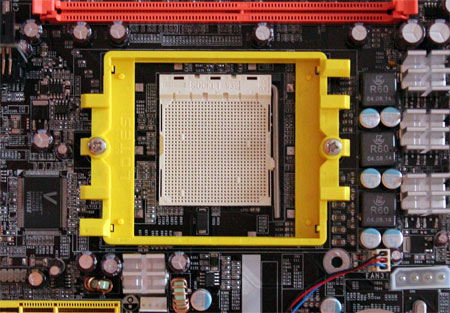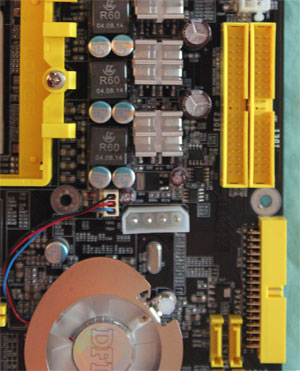DFI nForce4: SLI and Ultra for Mad Overclockers
by Wesley Fink on February 5, 2005 9:30 AM EST- Posted in
- Motherboards
Board Layout: DFI nForce4
Each new generation of DFI motherboards seem to be improving on board design, and the DFI nForce4 boards feature a very functional layout.

The DFI nF4 places the CPU in the top center of the board and DIMMs at the top. This arrangement worked well in our testing and should work better for those who change memory frequently than the crowded right edge location used on most boards.

The ATX 24-pin and the 4-pin 12V connector are in ideal locations on the DFI nF4. The bulky 24-pin ATX is located on the preferred top right edge of the motherboard, and the 4-pin 12V power connector is right beside it. This board-edge location keeps bulky cables away from the CPU and memory.

The CPU socket is in the top center of the board. PCI slots are below the socket and memory is above the CPU. There is plenty of room around the Socket 939, so most Heatsink/Fans should work fine. A Zalman 7000 overhung DIMM slot 4, but it still cleared our stock OCZ memory and dimms could work in all slots.

The IDE connectors are at our preferred upper right edge of the motherboard, and the floppy connector is a board edge connector about right midline of the board. Both locations are nearly ideal and worked well in our testing. If you use a floppy drive, you might want to connect the floppy before screwing down the board, as many mid-tower cases are tight in the area of the floppy connector. Having said that, we would still choose this floppy location any day over the floppy placed at the bottom of the board.

SATA connectors are to the right of the nF4 chipset and the magnetic levitation fan. The fan is low enough for video cards - both ATI and nVidia - to mount properly. We tried both ATI and nVidia top-of-the line cards to make sure.

Most competitive boards with 2 x16 PCIe video slots use a simple card edge selector that is reversed for SLI operation. DFI uses 6 jumper blocks that must all be moved to switch to SLI mode.
DFI also continues CMOS reloaded, which was introduced with the second generation LANParty boards. This feature allows you to save several different custom BIOS set-ups so that you can recall custom BIOS settings easily for a particular overclock or settings for a different OS. Overclockers and users who run multiple operating systems will really find CMOS Reloaded to be a useful feature.










114 Comments
View All Comments
ksherman - Wednesday, February 2, 2005 - link
damn i wish i had the money...Tiamat - Wednesday, February 2, 2005 - link
Wow, i really dig the board layout.erios666 - Wednesday, February 2, 2005 - link
Now if someone could get the Ultra-D to a 3 monitor span like a Matrox Parhelia then I'd be all over this board!sxr7171 - Wednesday, February 2, 2005 - link
Pretty confusing product line but nice boards.